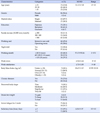2. Lakka TA, Laaksonen DE. Physical activity in prevention and treatment of the metabolic syndrome. Appl Physiol Nutr Metab. 2007; 02. 32(1):76–88. DOI:
10.1139/h06-113.

5. Esposito EM, Fitzpatrick JJ. Registered nurses' beliefs of the benefits of exercise, their exercise behaviour and their patient teaching regarding exercise. Int J Nurs Pract. 2011; 08. 17(4):351–356. DOI:
10.1111/j.1440-172X.2011.01951.x.

6. Oh EJ. Relationship between the health promoting behaviors and the quality of life among emergency room nurses [master's thesis]. Jinju: Gyeong Sang National University;2004. 84.
7. Peplonska B, Bukowska A, Sobala W. Rotating night shift work and physical activity of nurses and midwives in the cross-sectional study in Lodz, Poland. Chronobiol Int. 2014; 12. 31(10):1152–1159. DOI:
10.3109/07420528.2014.957296.

8. Cho YS, Park J, Ryu SY, Kang MG, Min S, Kim HS, et al. Influence of organizational culture and health promotion life style on job satisfaction in general hospitals nurses. J Korean Public Health Nurs. 2012; 04. 26(1):5–15. DOI:
10.5932/JKPHN.2012.26.1.005.

9. Kho HJ, Kim MY, Kwon YS, Kim CN, Park KM, Park JS, et al. The fatigue experience of shift work nurses. J Korea Community Health Nurs Acad Soc. 2004; 03. 18(1):103–118.
10. Lee EJ, Shin SW. The effect of health promotion behavior on fatigue and depression among shift nurses. J Korea Acad Ind coop Soc. 2014; 15(4):2256–2264. DOI:
10.5762/KAIS.2014.15.4.2256.

11. Kim SY, Kwon IS, Cho YC. Relationship between job stress and fatigue symptoms among nurses in a university hospital. J Korea Acad Ind coop Soc. 2012; 13(4):1759–1768. DOI:
10.5762/KAIS.2012.13.4.1759.

12. Chung CH, Kang HY. Job stress and fatigue of the nurses in the operating room. J Korea Contents Assoc. 2013; 13(12):291–298. DOI:
10.5392/JKCA.2013.13.12.291.

13. Park AS, Kwon IS, Cho YC. Fatigue symptoms and its related factors among general hospital nurses. J Korea Acad Ind coop Soc. 2009; 10(8):2164–2172. DOI:
10.5762/KAIS.2009.10.8.2164.

14. Jurakic D, Golubic A, Pedisic Z, Pori M. Patterns and correlates of physical activity among middle-aged employees: a population-based, cross-sectional study. Int J Occup Med Environ Health. 2014; 06. 27(3):487–497. DOI:
10.2478/s13382-014-0282-8.

16. Faul F, Erdfelder E, Lang AG, Buchner A. G*Power 3: a flexible statistical power analysis program for the social, behavioral, and biomedical sciences. Behav Res Methods. 2007; 05. 39(2):175–191.

18. Craig CL, Marshall AL, Sjostrom M, Bauman AE, Booth ML, Ainsworth BE, et al. International physical activity questionnaire: 12-country reliability and validity. Med Sci Sports Exerc. 2003; 08. 35(8):1381–1395. DOI:
10.1249/01.MSS.0000078924.61453.FB.

20. Yun YH, Wang XS, Lee JS, Roh JW, Lee CG, Lee WS, et al. Validation study of the korean version of the brief fatigue inventory. J Pain Symptom Manage. 2005; 02. 29(2):165–172. DOI:
10.1016/j.jpainsymman.2004.04.013.

21. Hwang JH, Chang HJ, Shim YH, Park WH, Park W, Huh SJ, et al. Effects of supervised exercise therapy in patients receiving radiotherapy for breast cancer. Yonsei Med J. 2008; 06. 49(3):443–450. DOI:
10.3349/ymj.2008.49.3.443.

22. Lee JH, Jeong HS, Lim SM, Cho HB, Ma JY, Ko E, et al. Reliability and validity of the fatigue severity scale among university student in South Korea. Korean J Biol Psychiatry. 2013; 20(1):6–11.
23. Yun YH, Lee MK, Chun HN, Lee YM, Park SM, Mendoza TR, et al. Fatigue in the general Korean population: application and normative data of the brief fatigue inventory. J Pain Symptom Manage. 2008; 09. 36(3):259–267. DOI:
10.1016/j.jpainsymman.2007.10.016.

24. Vandelanotte C, Short C, Rockloff M, Di Millia L, Ronan K, Happell B, et al. How do different occupational factors influence total, occupational and leisure-time physical activity? J Phys Act Health. 015; 02. 12(2):200–207.

26. Lee YS, Park HK, Kim HJ, Jung YH. Effects of foot bath therapy on operating room nurses' lower extremities edema, stress, and fatigue. J Korean Clin Nurs Res. 2014; 04. 20(1):102–112.
27. Moon HS. Work stress and health condition of nurses and female teachers [master's thesis]. Seoul: Hanyang University;2012. 59.
28. Rice V, Glass N, Ogle KR, Parsian N. Exploring physical health perceptions, fatigue and stress among health care professionals. J Multidiscip Healthc. 2014; 04. 01. 7:155–161. DOI:
10.2147/JMDH.S59462.

29. Kim YI. Effect factors on health promotion lifestyle of shift work nurses. Korean J Occup Health Nurs. 2011; 20(3):356–364. DOI:
10.5807/kjohn.2011.20.3.356.

30. Theorell-Haglow J, Lindberg E, Janson C. What are the important risk factors for daytime sleepiness and fatigue in women? Sleep. 2006; 06. 01. 29(6):751–757. DOI:
10.1093/sleep/29.6.751.







 PDF
PDF ePub
ePub Citation
Citation Print
Print





 XML Download
XML Download